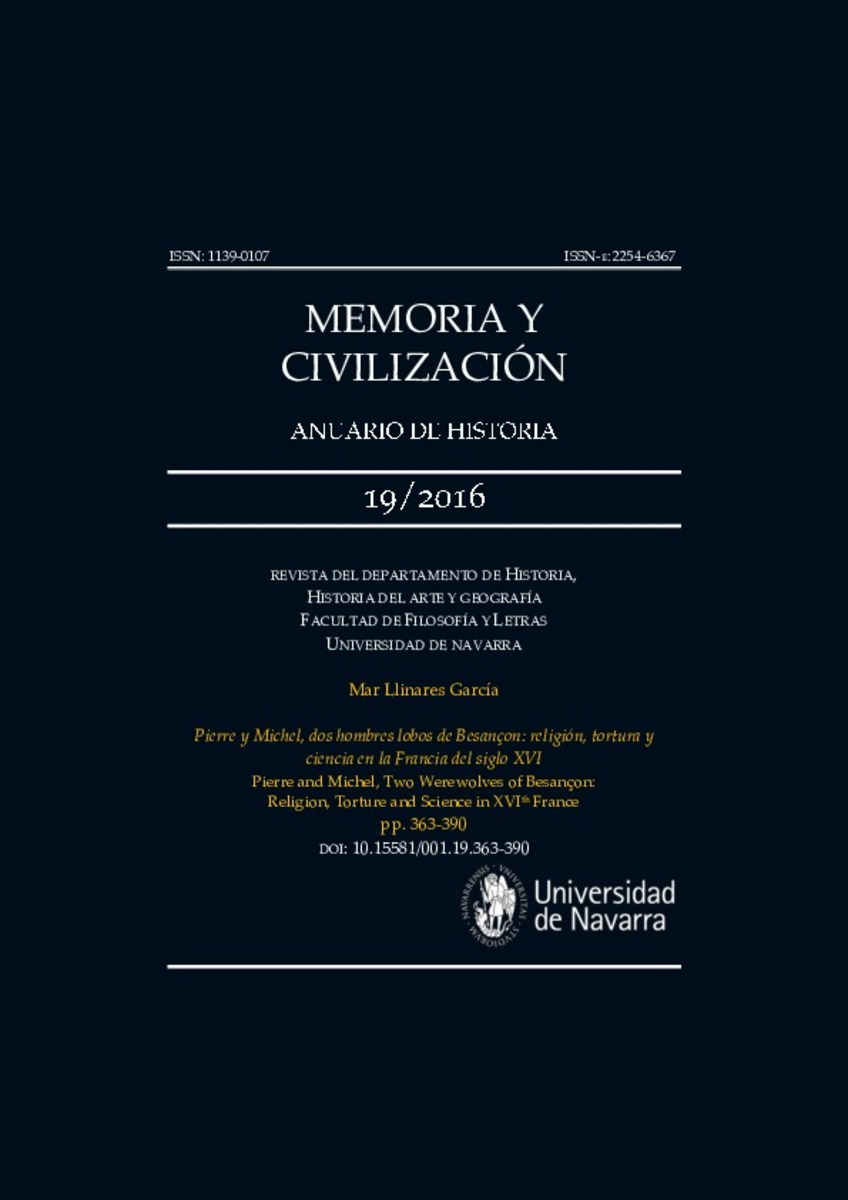Full metadata record
| DC Field | Value | Language |
|---|---|---|
| dc.creator | Llinares-García, M.M. (María del Mar) | - |
| dc.date.accessioned | 2017-01-16T09:22:38Z | - |
| dc.date.available | 2017-01-16T09:22:38Z | - |
| dc.date.issued | 2016 | - |
| dc.identifier.citation | Llinares-García, M. M. (2016). Pierre y Michel, dos hombres lobo de Besançon: religión, tortura y ciencia en la Francia del siglo XVI. Memoria y Civilización Nº 19, pp. 363-390 | es_ES |
| dc.identifier.issn | 1139-0107 | - |
| dc.identifier.uri | https://hdl.handle.net/10171/42705 | - |
| dc.description.abstract | El estudio histórico e histórico jurídico de los procesos por brujería y otros crímenes como la licantropía o el culto satánico son muy difíciles porque en algunos países, como Francia, las actas de los juicios eran quemadas junto al condenado. Además, la mezcla de hechos, ideas religiosas y supersticiones incrementa todavía más el número de los problemas que el estudio de estos juicios trae consigo. En este artículo, partiendo del libro de Jean Wier De praestigiis daemonum, se analiza el juicio contra Pierre y Michel, dos hombres lobo de la ciudad de Besançon en la Francia del siglo XVI. Jean Wier escribió un extenso resumen de esas actas judiciales y estudió la verosimilitud de los cargos imputados. Jean Wier, un médico católico y un humanista que vivió en la Europa de las guerras de religión del siglo XVI, negó el valor de los juicios por brujería, licantropía y cultos satánicos, porque creía que los hechos imaginarios de las acusaciones muchas veces no eran más que invenciones de pobres e ignorantes campesinos. | es_ES |
| dc.description.abstract | The historical and historical-legal study of the processes by witchcraft and other crimes such as lycanthropy or satanic cult are very difficult because in some countries, such as France, minutes of the trials were burned by the condemned. In addition, the mixture of facts, religious ideas and superstitions further increases the number of problems that the study of these trials entails. This article analyzes the trial of Pierre and Michel, two werewolves in the city of Besancon in France in the sixteenth century, based on the book by Jean Wier De Praestigiis daemonum. Jean Wier wrote a lengthy summary of those court records and studied the plausibility of the charges. Jean Wier, a Catholic doctor and a humanist who lived in Europe during the religious wars of the sixteenth century, denied the value of the witchcraft, lycanthropy and satanic cults trials, because he believed that imaginary facts of the accusations were often no more than inventions of poor and ignorant peasants. | es_ES |
| dc.language.iso | spa | es_ES |
| dc.publisher | Servicio de Publicaciones de la Universidad de Navarra | es_ES |
| dc.rights | info:eu-repo/semantics/openAccess | es_ES |
| dc.subject | Jean Wier | es_ES |
| dc.subject | Superstición | es_ES |
| dc.subject | Religión | es_ES |
| dc.subject | Juicios | es_ES |
| dc.subject | Licantropía | es_ES |
| dc.title | Pierre y Michel, dos hombres lobo de Besançon: religión, tortura y ciencia en la Francia del siglo XVI | es_ES |
| dc.title.alternative | Pierre and Michel, Two Werewolves of Besançon: Religion, Torture and Science in XVIth France | es_ES |
| dc.type | info:eu-repo/semantics/article | es_ES |
| dc.identifier.doi | 10.15581/001.19.7175 | es_ES |
Files in This Item:
Statistics and impact
Items in Dadun are protected by copyright, with all rights reserved, unless otherwise indicated.






